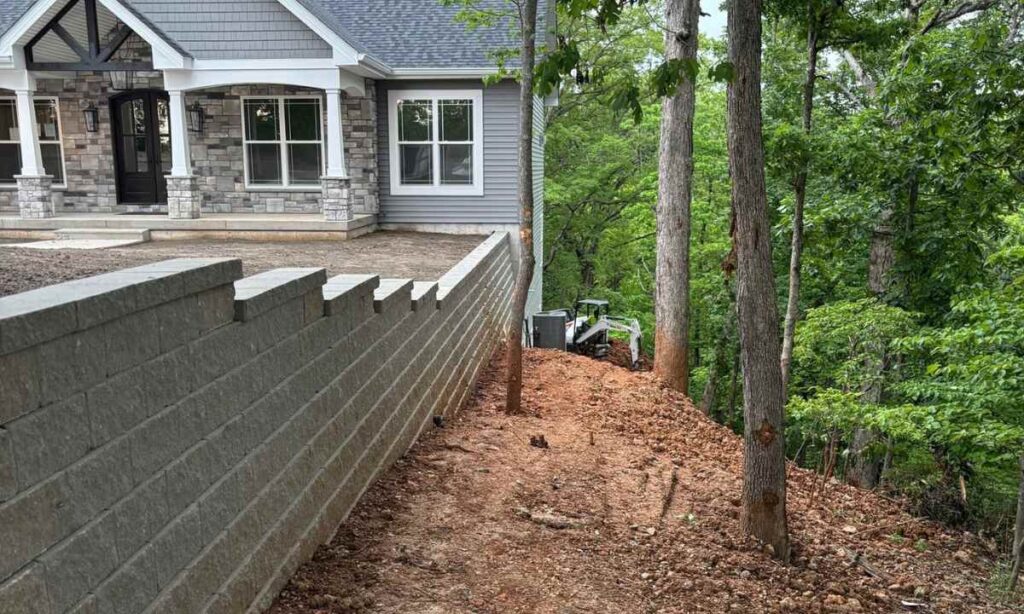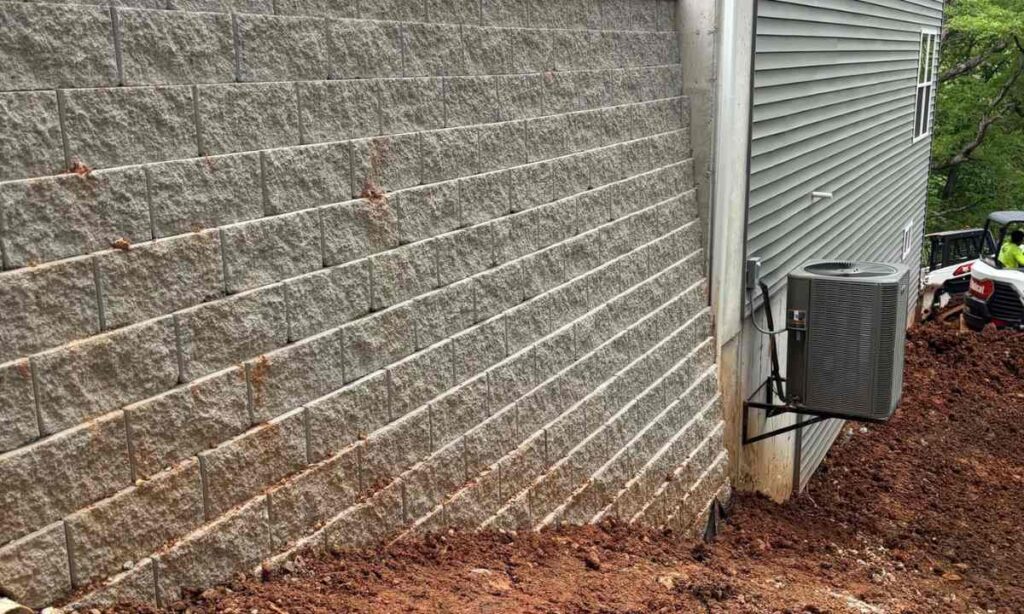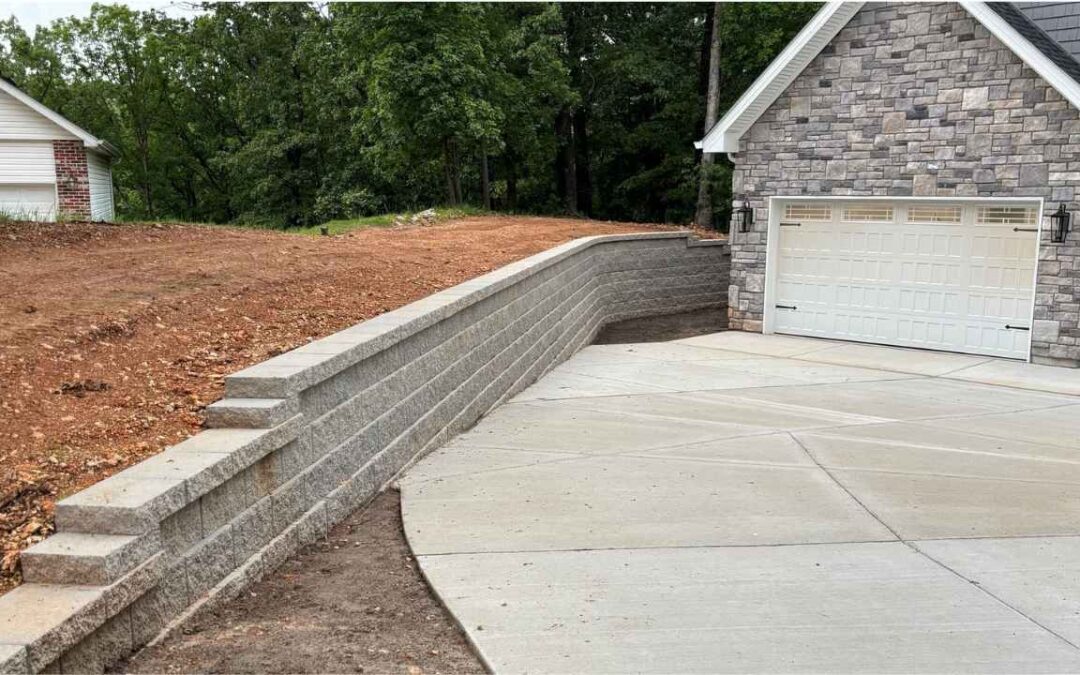The best time to build a retaining wall in St. Louis depends on weather conditions, soil stability, and local permitting timelines. Seasonal shifts in the Midwest can directly affect how well your retaining wall performs and how smoothly your construction process goes. Breaking down each season in St. Louis, explaining the pros and cons of building during spring, summer, fall, or winter. Whether you’re a homeowner managing a sloped yard or a contractor planning ahead, understanding the seasonal landscape helps you time your project for safety, efficiency, and long-term durability.
Why Seasonal Timing Impacts Retaining Wall Success
St. Louis’ freeze-thaw cycles and wet clay soil can cause wall movement, erosion, and drainage issues.
The timing of your build affects:
- Soil moisture and compaction — wet or frozen ground leads to poor base stability
- Permit processing speeds — delays may occur in winter or during spring backlogs
- Construction timelines — weather-related stoppages or material delivery issues are more common in certain months
That’s why smart builders in Missouri don’t just ask “how,” but “when.”

Spring: A Popular but Risky Choice
Spring is often seen as the start of construction season but it’s not always ideal.
- Soils are still saturated from melting snow and seasonal rain, reducing compaction strength
- Demand for permits spikes, leading to longer approval times
- Mud and moisture slow excavation, equipment movement, and base prep
If you’re set on spring, wait until late April or early May when conditions begin to stabilize.
Best for: Homeowners who want to finish early in the year and can wait for dry windows.
Summer: Ideal Ground Conditions, Higher Demand
Summer offers dry, stable conditions but competition for crews and materials is intense.
- Dry, warm soil compacts well and supports quicker construction
- Fewer rain delays mean smoother scheduling and predictable timelines
- High contractor demand can drive up pricing or limit availability
Start planning in spring to lock in your contractor before peak season hits.
Best for: Large projects or reinforced walls where dry, solid soil is critical.
Fall: The Sweet Spot for Retaining Wall Projects
Fall is often the best balance between weather, pricing, and availability.
- Cooler temps and dry soil provide optimal conditions for excavation and wall stability
- Contractors have more availability after summer rush
- You beat the freeze, which allows backfill and drainage to settle before winter
Early fall (September to early October) is the ideal window.
Best for: Homeowners looking for a cost-effective, lower-risk build.
Winter: Limited by Frost and Frozen Ground
Winter builds are rare in St. Louis and for good reason.
- Frozen soil is unstable and hard to excavate
- Concrete and adhesives used in caps or footings may not cure properly
- Permit offices and suppliers may reduce hours or inventory in off-season
Still, some professionals build retaining walls in mild winters or with heat blankets and special curing techniques.
Best for: Emergency repairs or experienced contractors with weather-adaptive methods.
Missouri Specific Factors That Influence Timing

How do St. Louis soil types affect scheduling?
St. Louis clay expands when wet and shrinks when dry, which affects wall alignment and drainage.
- Avoid digging when the ground is saturated
- Plan ahead for extra gravel, geogrid, or drainage pipe during wetter months
- Use USDA Missouri Soil Survey to learn about your yard’s profile
When do permit backlogs typically happen?
Spring and early summer are the busiest seasons for local permit offices.
To avoid delays:
- Submit permit applications in winter or early spring
- Factor in a few extra weeks during March-June due to inspection bottlenecks
For more info, review the St. Louis County Residential Code.
Smart Scheduling Tips for Homeowners in St. Louis
How can I prepare for a summer or fall build?
- Book your contractor early — at least 2–3 months ahead
- Get your site surveyed for slope, utilities, and drainage
- Order materials in advance to avoid shortages during peak demand
Before breaking ground, it’s worth speaking with a retaining wall supplier in St. Louis who understands both the material and seasonal timing needed for durable results.
What if I have drainage issues now?
- Schedule a drainage consultation even before the wall
- Interim solutions (like grading or temporary barriers) can help until dry season
- A wall installed at the right time can eliminate recurring erosion problems
Common Questions About Retaining Wall Timing in St. Louis
Can I build a retaining wall in winter?
Usually no, unless the ground is unfrozen and temps stay above 40°F.
What month is cheapest to build?
Late summer to early fall often offers the best contractor pricing.
Do I need a permit before scheduling?
Yes, for any wall over 3–4 ft or near a structure. Get this process started early.
What happens if I build during a wet spring?
Expect delays, compaction issues, and possible erosion if drainage isn’t managed.
Build Smarter, Not Just Sooner
Your retaining wall will only be as strong as the season you choose to build it in. Whether it’s erosion control, yard leveling, or a landscape feature, the right timing makes the job smoother and your structure stronger. At Retaining Wall & Paving Solutions, we help St. Louis homeowners plan their retaining wall project from the ground up. Our local team understands the timing, soil, and code requirements unique to the region. If you’re planning ahead for a summer or fall build, our St. Louis retaining wall experts can help ensure your project starts on the right footing.
